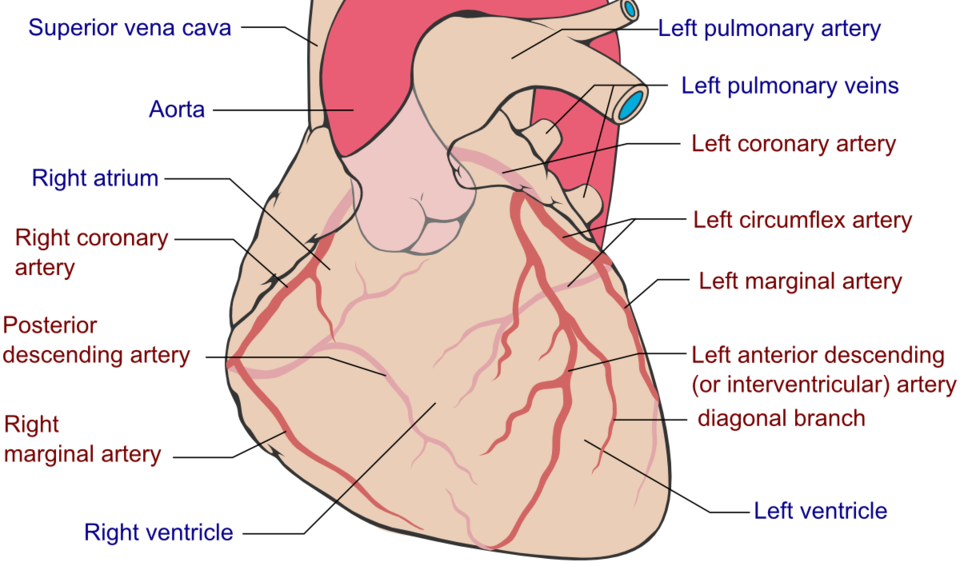Cardiology > Takotsubo cardiomyopathy
Takotsubo cardiomyopathy
Empty
1. Knuuti J, Wijns W, Saraste A, Capodanno D, Barbato E, Funck-Brentano C, et al. 2019 ESC Guidelines for the diagnosis and management of chronic coronary syndromes. Eur Heart J. 2020;41(3):407-477.
PMID: 31504439
DOI: https://doi.org/10.1093/eurheartj/ehz425
2. Fihn SD, Gardin JM, Abrams J, Berra K, Blankenship JC, Dallas AP, et al. 2012 ACCF/AHA/ACP/AATS/PCNA/SCAI/STS guideline for the diagnosis and management of patients with stable ischemic heart disease. J Am Coll Cardiol. 2012;60(24):e44-e164.
PMID: 23182125
DOI: https://doi.org/10.1016/j.jacc.2012.07.013
3. Khan MA, Hashim MJ, Mustafa H, Baniyas MY, Al Suwaidi SKBM, AlKatheeri R, et al. Global epidemiology of ischemic heart disease: Results from the Global Burden of Disease Study. Cureus. 2020;12(7):e9349.
PMID: 32742886
DOI: 10.7759/cureus.9349
4. Ibanez B, James S, Agewall S, Antunes MJ, Bucciarelli-Ducci C, Bueno H, et al. 2017 ESC Guidelines for the management of acute myocardial infarction in patients presenting with ST-segment elevation. Eur Heart J. 2018;39(2):119-177.
PMID: 28886621
DOI: https://doi.org/10.1093/eurheartj/ehx393
5. Amsterdam EA, Wenger NK, Brindis RG, Casey DE Jr, Ganiats TG, Holmes DR Jr, et al. 2014 AHA/ACC guideline for the management of patients with non–ST-elevation acute coronary syndromes. J Am Coll Cardiol. 2014;64(24):e139-e228.
PMID: 25260716
DOI: https://doi.org/10.1016/j.jacc.2014.09.017
Background
Takotsubo cardiomyopathy (TTC), also known as stress cardiomyopathy or broken heart syndrome, is a transient cardiac syndrome characterized by acute left ventricular (LV) systolic dysfunction in the absence of obstructive coronary artery disease. It mimics acute myocardial infarction, often presenting with chest pain and ECG changes, but without significant coronary blockage. The term “Takotsubo” comes from a Japanese octopus trap, reflecting the classic apical ballooning of the LV observed on imaging.
II) Classification/Types
By Anatomic Variant (Wall Motion Pattern):
- Apical type (classic): Apical ballooning with basal hyperkinesis
- Midventricular type: Mid-LV hypokinesis, sparing apex and base
- Basal (inverse) type: Basal hypokinesis with apical hyperkinesis
- Focal type: Localized wall motion abnormality
- Global type: Diffuse LV hypokinesis (rare)
By Trigger Type:
- Emotional stress-induced (e.g., grief, fear)
- Physical stress-induced (e.g., stroke, sepsis, surgery)
- No identifiable trigger
III) Pathophysiology
Takotsubo cardiomyopathy is thought to result from catecholamine surge-induced myocardial stunning due to acute emotional or physical stress. The exact mechanism is not fully understood, but potential contributors include:
- Microvascular dysfunction
- Myocardial energy metabolism impairment
- Direct catecholamine-mediated myocardial toxicity
- Coronary artery spasm
This leads to transient systolic dysfunction typically involving the apical and mid-ventricular segments.
IV) Epidemiology
- Sex: ~90% of cases occur in postmenopausal women
- Age: Most common in women >50 years
- Geography: Reported worldwide; increasing recognition with more use of angiography
- Comorbidities: May coexist with anxiety, depression, neurological disorders, and malignancy
Etiology
I) Causes
- Emotional stress (e.g., death of a loved one, panic attack)
- Physical stress (e.g., acute illness, surgery, stroke, trauma)
- Acute neurologic conditions (e.g., subarachnoid hemorrhage, seizure)
- Use of catecholamines (e.g., epinephrine, dobutamine)
- Idiopathic (no identifiable stressor in some patients)
II) Risk Factors
- Female sex
- Postmenopausal status
- Recent intense emotional or physical stress
- Pre-existing psychiatric or neurologic disorders
- Use of catecholaminergic medications
Clinical Presentation
I) History (Symptoms)
- Acute-onset chest pain (similar to MI)
- Dyspnea
- Palpitations
- Syncope
- May occur after a stressful event (emotional or physical)
- In severe cases: cardiogenic shock, heart failure, arrhythmias
II) Physical Exam (Signs)
Vital Signs:
- May be normal or show hypotension, tachycardia
- Rarely: signs of shock
Cardiac Exam:
- Often normal
- S4 gallop or systolic murmur if LV outflow obstruction present
Pulmonary:
- Rales if pulmonary edema
- Hypoxia in severe LV dysfunction
Peripheral:
- May have signs of low perfusion (cold extremities, weak pulses)
Differential Diagnosis (DDx)
- Acute coronary syndrome (STEMI/NSTEMI)
- Myocarditis
- Pulmonary embolism
- Aortic dissection
- Pheochromocytoma
- Sepsis-induced cardiomyopathy
- Hypertrophic obstructive cardiomyopathy (HOCM)
- Pericarditis
Diagnostic Tests
Initial Tests:
Electrocardiogram (ECG):
- ST-segment elevation (often precordial leads)
- T-wave inversion
- QT prolongation
- LBBB or new Q waves occasionally
Cardiac Biomarkers:
- Elevated troponins (usually modest vs MI)
- Elevated BNP or NT-proBNP
Chest X-ray:
- Pulmonary edema
- Normal or cardiomegaly
Transthoracic Echocardiogram (TTE):
- Regional wall motion abnormalities not confined to a single coronary artery
- Apical ballooning or other variant wall motion pattern
- May show LV outflow tract obstruction or mitral regurgitation
Coronary Angiography:
- No significant coronary artery obstruction (required to rule out MI)
Cardiac MRI:
- Helps differentiate TTC from myocarditis or infarction
- Absence of late gadolinium enhancement
Treatment
I) Medical Management:
Supportive Care:
- Often self-limiting with complete recovery within weeks
- Admit and monitor (initial management similar to ACS)
Heart Failure Management (if present):
- Diuretics
- ACE inhibitors or ARBs
- Beta-blockers (used cautiously if LVOT obstruction is present)
Anticoagulation:
- Consider if apical akinesis or LV thrombus risk
Avoid:
- Inotropes if possible (may worsen catecholamine toxicity)
- Nitrates in LVOT obstruction
II) Interventional/Surgical:
- Rarely needed
- Intra-aortic balloon pump (IABP) or mechanical support in cardiogenic shock
Patient Education, Screening, Vaccines
- Educate about the transient nature and favorable prognosis
- Avoid emotional and physical stressors when possible
- Monitor for recurrence (about 5-10% risk)
- Smoking cessation, stress-reduction strategies (e.g., therapy, meditation)
Vaccinations:
- Influenza annually
- Pneumococcal vaccine
- COVID-19 vaccination
Consults
- Cardiology: Required for diagnosis and management
- Psychiatry/Psychology: If emotional trigger or underlying mood disorder
- Primary Care/Internal Medicine: For long-term monitoring and prevention
- Neurology: If associated neurologic condition (e.g., seizure, stroke)
Follow-Up
- Repeat Echocardiogram: 4–8 weeks to confirm recovery
- Cardiac MRI: In unclear cases or atypical course
- Monitor for recurrence
- Beta-blockers: Consider long-term in selected patients, though benefit is uncertain
- Address mental health: Evaluate for depression/anxiety and provide support
Recommended
- Myocarditis
- Dilated cardiomyopathy
- Hypertrophic Cardiomyopathy
- Restrictive cardiomyopathy
- Alcoholic Cardiomyopathy
- Peripartum (Postpartum) Cardiomyopathy (PPCM)
- Takotsubo (Stress) Cardiomyopathy (Broken Heart Syndrome)
- Cardiac cirrhosis (congestive hepatopathy)
- Cocaine-Related Cardiomyopathy
- Endomyocardial Fibrosis
- Cardiac amyloidosis
- Myopathies
- Postpericardiotomy Syndrome

Stay on top of medicine. Get connected. Crush the boards.
HMD is a beacon of medical education, committed to forging a global network of physicians, medical students, and allied healthcare professionals.
